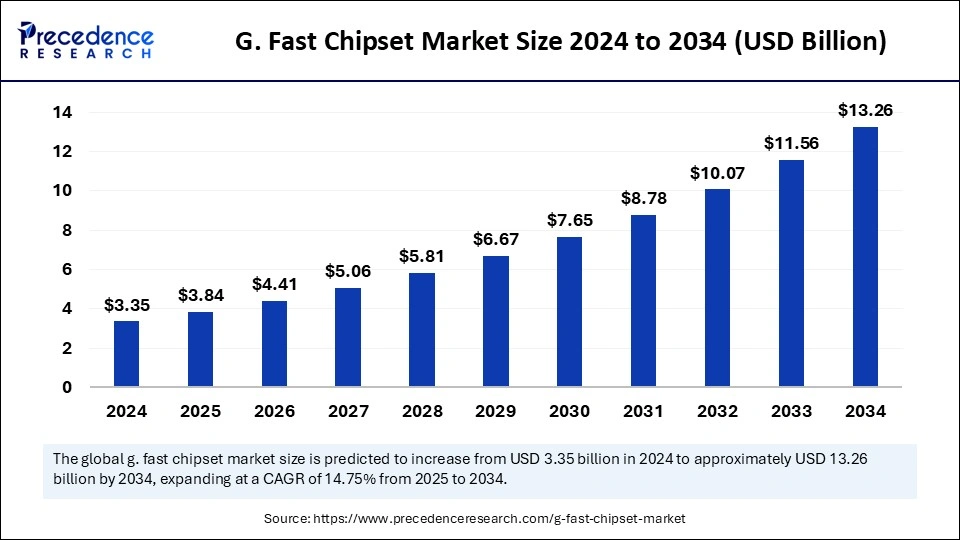
G. Fast Chipset Market Key Takeaways
- North America led the G. fast chipset market with the largest market share of 40% in 2024.
- Asia Pacific is expected to expand at the fastest rate during the forecast period.
- By technology, the wireless solutions segment held a major market share in 2024.
- By technology, the fiber to the node segment is expected to grow at a notable CAGR during the projection period.
- By configuration, the integrated chipsets segment dominated the market in 2024.
- By configuration, the stand-alone chipsets segment is likely to witness significant CAGR between 2025 and 2034.
- By application, the broadband access segment contributed the biggest market share in 2024.
- By application, the smart home devices segment is projected to grow at a notable rate in the coming years.
- By end-use, the residential segment held the biggest market share in 2024.
- By end-use, the commercial segment is anticipated to observe significant growth over the studied period.
G. Fast Chipset Market Overview
G.fast chipset market is evolving rapidly as service providers aim to deliver gigabit broadband speeds using existing copper and coaxial networks from the telecommunications infrastructure point of view. G.fast technology enables high-speed internet access over short copper loops, serving as a cost-effective alternative to full fiber deployment, especially in densely populated urban environments. The demand for last-mile connectivity solutions that are both fast and financially viable has propelled the growth of G.fast chipsets in telecom networks worldwide.
G. Fast Chipset Market Drivers
The primary drivers include the growing demand for high-speed broadband, the need to upgrade existing legacy infrastructure without costly overhauls, and the push from governments and regulators to enhance digital inclusion. Telecom operators are turning to G.fast as a strategic solution to meet gigabit broadband targets while avoiding the expenses associated with full fiber rollouts.
G. Fast Chipset Market Opportunities
Opportunities abound in upgrading aging DSL networks in regions where fiber deployment is still lagging. The integration of G.fast chipsets with network virtualization and software-defined networking (SDN) is opening new avenues for operational efficiency and scalability. Additionally, emerging markets with significant copper infrastructure offer an untapped potential for chipset deployment.
There is an increased awareness among consumers and service providers, and government regulations to reduce environmental impact are ongoing worldwide. The emphasis on sustainable connectivity is expected to create lucrative growth opportunities in this market. The growing concerns related to energy consumption can be addressed by focusing on sustainable options that improve energy efficiency and power consumption without compromising performance.
Developing practices that can help reduce the environmental impact, like integrating advanced technology, sustainable materials utilization, and minimizing waste, can help improve sustainability. Minimizing the infrastructure’s carbon footprint further opens new growth avenues for this market.
G. Fast Chipset Market Challenges
Challenges include interference issues and performance degradation over longer loop lengths. The presence of newer, competing technologies such as fiber-to-the-home (FTTH) and 5G fixed wireless access (FWA) also poses a threat to the long-term viability of G.fast. Furthermore, regulatory hurdles and inconsistent standards across regions can hamper smooth implementation.
G. Fast Chipset Market Regional Insights
Europe is a key market, driven by its dense urban settings and legacy copper infrastructure. Countries like the UK and Germany are actively deploying G.fast as a bridge technology toward full fiber. North America is adopting it selectively, while Asia-Pacific, especially South Korea and Japan, are focused more on fiber but still see potential in hybrid deployments. Latin America and Eastern Europe are emerging markets where cost-effective broadband upgrades are urgently needed.
G. Fast Chipset Market Recent Developments
Recent developments include partnerships between telecom operators and chipset vendors to roll out pilot projects and scaled deployments. Innovation in vectoring and bonding technologies is also enhancing the performance of G.fast. Some countries have integrated G.fast solutions into their national broadband plans to speed up digital access.
- In March 2025, Qualcomm launched three new Snapdragon G series chips. These chips are specifically designed to power Android handled gaming devices.
- In August 2024, Google launched its Pixel 9 series with the new Tensor G4 chip. This chip is a custom processor that enhances performance and drives AI-powered features in Pixel 9 series.
G. Fast Chipset Market Companies
- Intel
- Texas Instruments
- MediaTek
- Qualcomm
- Infineon Technologies
- Nokia
- Cypress Semiconductor
- Marvell
- Analog Devices
- Microchip Technology
- Broadcom
- Samsung Electronics
- Realtek
- MaxLinear
- Huawei Technologies
Segments Covered in the Report
By Technology
- Fiber to the Node
- Fiber to the Curb
- Wireless Solutions
By Configuration
- Integrated Chipsets
- Stand-alone Chipsets
By Application
- Broadband Access
- Telecommunications
- Data Centers
- Smart Home Devices
By End-Use
- Residential
- Commercial
By Region
- North America
- Europe
- South America
- Asia Pacific
- Middle East and Africa